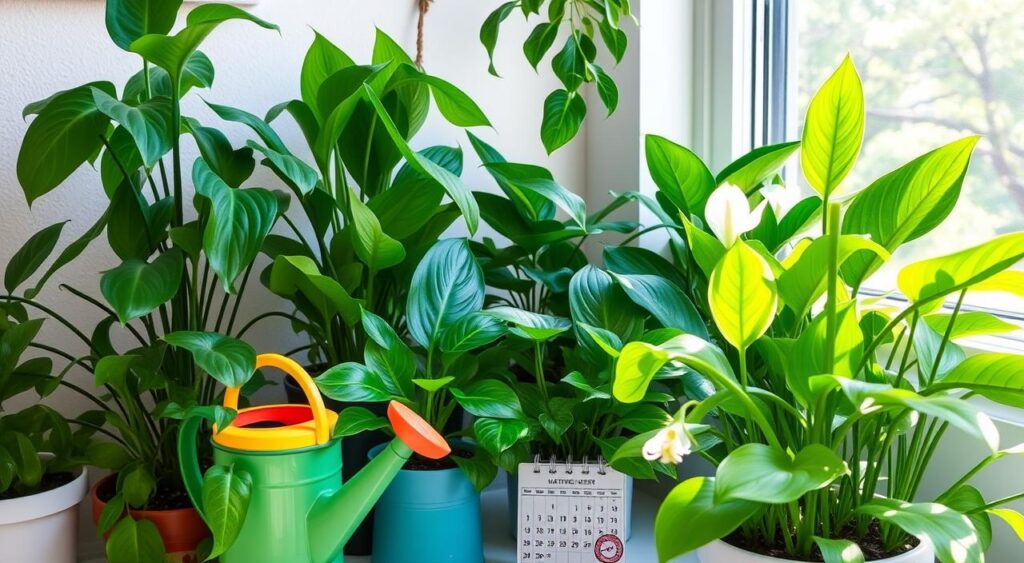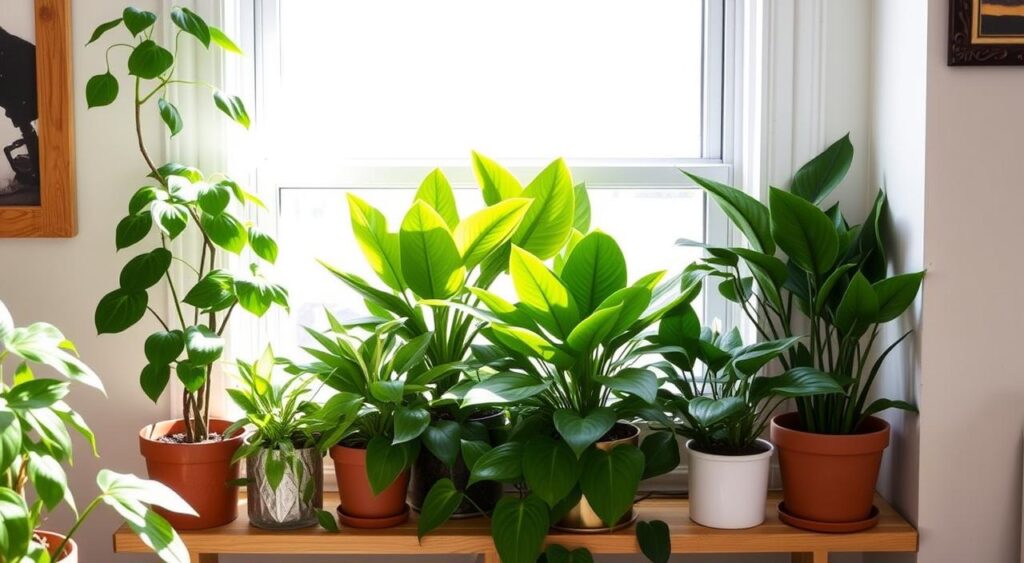Watering Indoor Plants Correctly Easy Tips
Are you unsure about watering your plants? With this beginner indoor plant guide, you’ll leave uncertainty behind. It’s all about finding the right balance. This means knowing when your plants have enough water and when they don’t. Our guide is perfect for anyone new to plant care or looking to keep their indoor garden thriving.
Sometimes, giving your plants too much love could harm them, while not enough could leave them dry. This guide helps you water your plants perfectly. Ready to start? Let’s make sure your indoor garden is healthy and full of life!
Key Takeaways
- Discover the golden rules of proper plant watering tailored for beginners.
- Prevent common watering mishaps that lead to unhappy, unhealthy plants.
- Grasp the importance of proper hydration techniques for indoor plants.
- Gain insight into the delicate balance required for optimal plant growth.
- Receive guidance on crafting a fail-proof watering schedule for diverse plant species.
- Learn to interpret the subtle signs your indoor plants are thirsty or drowning.
Understanding Your Indoor Plant’s Watering Needs
Every person who loves indoor plants needs to know how to water them right. Proper watering keeps your plants healthy. It can be very different for each type of plant.
The Importance of Knowing Your Plant Species
Knowing what your plants need is key. For example, succulents need less water than plants like Monstera. When you understand this, taking care of plants gets easier. This makes starting with indoor plants more fun.
Signs of Overwatering vs Underwatering
Too much water turns leaves yellow and makes plants wilt. Not enough water leads to dry, crispy leaves. You can avoid both problems by checking the soil. This keeps your plants healthy and growing well.
Adjusting Watering by Season
Plants’ water needs change with the seasons, just like ours. They need more water when growing. But you should water them less in the winter. This helps plants stay healthy and grow strong.
This guide helps you take care of indoor plants easily. It’s great for beginners too. Knowing what your plants need makes for a happy indoor garden.
Choosing the Right Water for Your Plants
For your indoor plants to thrive, they need more than light and soil. Picking the correct water type is key. This section talks about water sources for beginner indoor plants. It also covers what you should think about with each type.
Tap Water Considerations
Tap water is easy to get, but it’s not always best for indoor plants. It often has chlorine and fluoride, which are safe for us but bad for delicate plants. Over time, these chemicals can build up and harm the plant’s health.
The Benefits of Distilled or Rainwater
Experienced indoor plant owners often use distilled or rainwater. These don’t have the chemicals found in tap water. Distilled water or collected rainwater is clean and usually better for your plants.
| Water Type | Pros | Cons | Suggested Plants |
|---|---|---|---|
| Tap Water | Readily available, low cost | Possible chemicals like chlorine and fluoride | Tougher plants, such as Snake plant |
| Distilled Water | Free of additives, neutral pH | Cost of distillation | Sensitive plants, such as African violets |
| Rainwater | Naturally soft, no chemicals | Need for collection and storage | Most indoor plants including Ferns |
Knowing about different water types helps your plants stay healthy. Choosing the right water is important for all indoor plants.
Essential Tools for Watering Indoor Plants
Starting an indoor garden becomes easier and better with the correct tools. These tools are must-haves for new gardeners. They help your indoor plants grow well.
- Watering Cans with Long Spouts: Provides precision and reach, minimizing spillage and ensuring water reaches the soil rather than the leaves.
- Spray Bottles: Essential for gently misting plants that thrive in higher humidity, such as tropical species.
- Moisture Meters: Take the guesswork out of when to water by measuring soil moisture levels accurately.
Getting these tools helps you take care of plants properly. It also makes looking after your indoor garden more enjoyable and successful.
| Tool | Use | Benefit |
|---|---|---|
| Watering Can with Long Spout | Watering deep into pots without wetting foliage | Prevents leaf fungus and root over-watering |
| Spray Bottle | Misting plants like ferns and air plants | Increases humidity, mimicking natural habitat |
| Moisture Meter | Checking soil wetness | Ensures optimal watering schedule |
Using the right tools, as the table shows, greatly helps in indoor gardening. These are not just helpers but crucial for keeping your plants healthy and vibrant. For new gardeners, such tools bring more happiness and less worry to your growing hobby.
How to Water Indoor Plants: A Step-by-Step Guide
Every indoor gardening fan needs to know how to water plants right. This guide helps you learn the basics of watering. It’s key for keeping your plants lively and well. Knowing when and how to water is vital, whether you’re a newbie or need a quick refresher.
Identifying the Best Time to Water
Watching your plants is the first step to water them properly. Most indoor plants like their soil a bit dry before you water again. But this can change based on the plant and where you live. A quick trick is to poke the soil with your finger. If it feels dry up to your first knuckle, it’s time to water.
Proper Water Distribution Techniques
To make sure water gets to the roots, sprinkle it evenly around the plant base. Keep going until you see water running out of the pot’s bottom. That means the soil has soaked up enough water. If your pot doesn’t have holes at the bottom, be careful not to add too much water.
How Often to Water Different Types of Indoor Plants
How often you should water varies a lot between plant species. For instance, succulents and cacti need water less often than tropical plants like Peace Lilies or ferns. Below is a simple table to help you out:
| Plant Type | Watering Frequency |
|---|---|
| Succulents and Cacti | Once every 2-3 weeks |
| Ferns | Once a week |
| Peace Lily | Every 5-7 days |
| Philodendron | Every 7-10 days |
| Snake Plant | Every 2-3 weeks |
Check the soil’s moisture level regularly. You may need to water more or less, especially when the seasons change. This way, each plant gets exactly what it needs. It matches the tips from a beginner indoor plant guide.
Common Mistakes When Watering Indoor Plants
When taking care of newbie indoor plants and low maintenance indoor plants, it’s easy to make watering errors. These mistakes can slow down their growth and harm their health. By knowing what to avoid, you can make your indoor garden thrive.
Overlooking Drainage
Good drainage stops root rot and fungal diseases. Not using pots with drainage holes is a mistake. Pots with holes let extra water out, keeping roots healthy.
Ignoring Plant Size and Pot Material
The size of your plant and the pot’s material matter a lot for watering. Terracotta pots need water more often than plastic ones. Big plants in tiny pots dry out fast and need more water.
| Pot Material | Watering Frequency | Additional Considerations |
|---|---|---|
| Terracotta | Higher | Absorbs moisture |
| Plastic | Lower | Retains moisture |
| Ceramic | Moderate | Often glazed, semi-porous |
Creating a Watering Schedule for Beginner-Friendly Indoor Plants
Starting a watering routine for indoor plants might feel overwhelming for beginners. Yet, focusing on plants that are easy for first-timers can make it much simpler. We’ll walk you through choosing plants that don’t need much work, how to set up reminders, and adjust your watering schedule when needed. These tips are perfect for those just starting with indoor plants.
Low Maintenance Indoor Plants and Watering Frequency
Plants like snake plants and ZZ plants are great for beginners because they don’t need much water. Knowing exactly what these easy-care plants need can help you water them just right.
Setting Up Reminders for Consistent Watering
Using technology can really help beginners keep up with their plants’ watering needs. Setting reminders on your phone or using an app can help make sure your plants get the water they need to stay healthy and grow.
Adjusting Your Schedule for Humidity and Temperature
Indoor conditions like humidity and temperature can change your plants’ watering needs. You might need to water your plants more often in dry or warm situations. But in cooler or more humid settings, they might not need as much water.
| Plant | Watering Frequency in Summer | Watering Frequency in Winter |
|---|---|---|
| Snake Plant | Every 2-3 weeks | Once a month |
| ZZ Plant | Every 2-4 weeks | Every 6 weeks |
| Pothos | Every 1-2 weeks | Every 3-4 weeks |
Maintaining Proper Humidity Levels for Indoor Plants
Keeping the right humidity level is key for indoor plant health and growth. This is especially true for easy care indoor plants and the best indoor plants for beginners. There are many ways to make sure your plants do well. You should try to copy their natural environment at home.
- Using humidifiers to add moisture to the air, benefiting plants that like it humid.
- Misting plants often can mimic the morning dew they’d get naturally.
- Putting plants close together creates an area with more humidity from their own water release.
For easy care indoor plants, moderate humidity usually works fine. This is doable in most homes. But plants from the tropics may need more moisture. This can be done with the methods mentioned above. A simple room hygrometer helps keep an eye on moisture. This ensures the best indoor plants for beginners have the perfect setting.
Your home’s climate is also crucial to consider. As seasons change, so does indoor moisture. In dry areas or during cold times, indoor heat can lower humidity. This isn’t good for your plants. But in moist areas or warmer times, you might not need to do much.
The Role of Soil in Watering Indoor Plant Strategies
Understanding how soil affects watering methods for indoor plants is key. It helps those wanting to grow the best indoor plants for beginners. Soil mix supports growth, holds water, and drains well. These are all vital for a plant’s health.
Choosing the Right Soil Mix
Selecting the proper soil mix helps your indoor plants stay moist without getting waterlogged. A good mix usually includes peat, perlite, and vermiculite. These ingredients help spread moisture evenly and allow extra water to drain away well.
Signs of Soil Water Saturation
Spotting water saturation in soil early can stop root damage. This damage can harm a plant’s health. Look for soil staying wet too long, a musty smell showing mold, or mold on the soil’s surface.
Here is a table discussing the signs of healthy versus saturated soil conditions and their impact on indoor plants for beginners:
| Condition | Signs | Impact on Plant Health |
|---|---|---|
| Healthy Soil | Moist but not soggy, earthy smell, loose texture | Ensures adequate air circulation and nutrient uptake |
| Saturated Soil | Water pools on surface, soggy texture, musty odor | Potential root rot, inhibited growth, and possible death |
For indoor plants for beginners, keeping the plant vibrant means checking these factors and tweaking how you water. Making sure the soil dries a bit between watering is also key. This helps keep your indoor garden healthy.
Self-Watering Systems and Plant Sitters for Beginners
Starting with indoor plants can make watering seem hard. Luckily, there are self-watering systems perfect for beginners. These make plant care easy and fun. With these systems, plants get just the right amount of water. This is great for busy times or when you’re away.
DIY Self-Watering Solutions
In our guide for beginners, we look at DIY self-watering ideas. They’re cheap and easy to make. You can use things like cotton string or old plastic bottles. These DIY projects let plants get water slowly and steadily. You can make them with things you already have. They make sure your plants do well, even if you can’t water them every day.
When to Consider a Professional Plant Sitter
Sometimes, DIY might not be enough. If you’ll be away for a long time, think about getting a plant sitter. These pros take great care of your plants. They check for stress or diseases too. With a plant sitter, your plants stay healthy and happy while you’re gone.
FAQ
How often should I water my indoor plants?
Watering needs vary by plant type, pot size, and environment. Check the top inch of soil to decide if it’s time to water.
What are the signs that I’m overwatering or underwatering my plants?
Overwatering shows as yellow leaves and mushy stems. For underwatering, look for dry leaves and soil that shrinks from the pot.
Should I adjust my watering routine with the change of seasons?
Yes. Plants need less water in winter. Adjust watering to fit the season, which helps mimic their natural setting.
Is tap water okay for my indoor plants, or should I use distilled water?
Tap water works for most plants. But for sensitive plants, avoid water with chlorine or fluoride. Use distilled or rainwater instead.
What tools should I invest in for watering my indoor plants?
Get a long-spout watering can, a spray bottle for misting, and a moisture meter. These tools make watering more effective.
Can you overwater a low-maintenance indoor plant?
Yes. Even easy-care plants can get overwatered. This might cause root rot and other problems.
How does pot size and material affect how much water a plant needs?
Big pots hold moisture longer than small ones. Terracotta dries out quickly, but plastic keeps moisture in. Choose what’s best for your plant.
How can I determine the best watering schedule for my plants?
Watch your plants to figure out their needs. Factors to consider include soil moisture and light. Apps can also help keep a regular watering schedule.
Why is maintaining proper humidity important for indoor plants?
Most indoor plants like humidity. It keeps them healthy, preventing dry leaves. It’s key for their well-being.
What role does soil play in watering my indoor plants?
Soil type affects water flow and holding capacity. Choosing the right mix is key to prevent waterlogging and ensure plant health.
Can I use a self-watering system for my plants?
Absolutely. Self-watering systems ensure steady moisture, perfect for busy people or beginners. Options range from simple to high-tech.
When is it appropriate to hire a professional plant sitter?
Hire a pro if you’re away a lot or have many plants. They can give the right care and attention your plants need.




